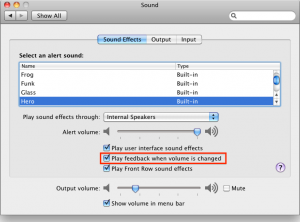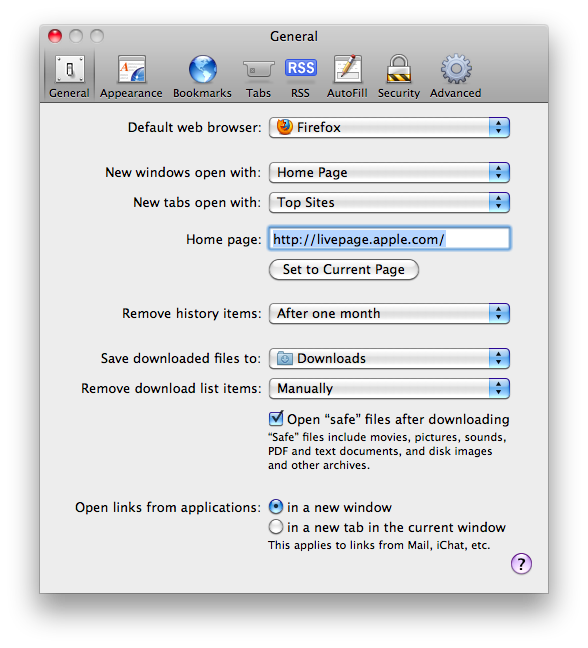You can change the location of the dock by clicking the Apple icon in the upper left and choosing what orientation you want for the dock from the Dock fly out menu.
iPhone will be a niche product in five years, or how to write a sensational headline
According to Kaspersky, the iPhone will be niche player in the smartphone market by 2015.
http://www.macworld.com/article/150904/2010/04/iphone_prediction.html
I don’t think even the biggest Apple haters of the world could agree with this guy.
Mac tip of the week: Disable volume change feedback
Apple throws Adobe a bone — on the Mac
Apple throws Adobe a bone — on the Mac: “
Filed under: Software
 Adobe’s Flash Player has never performed as well in Mac OS X as it does on Windows-running PCs. The traditionally poor performance of Adobe’s plugin on the Mac has led many iPhone and iPad users to support Apple’s decision to keep Flash off of its mobile devices. While the upcoming Flash 10.1 does boast some significant performance improvements over its predecessors, the performance is still pretty terrible compared to h.264, which has access to hardware-accelerated video decoding via the GPUs in Macs.
Adobe’s Flash Player has never performed as well in Mac OS X as it does on Windows-running PCs. The traditionally poor performance of Adobe’s plugin on the Mac has led many iPhone and iPad users to support Apple’s decision to keep Flash off of its mobile devices. While the upcoming Flash 10.1 does boast some significant performance improvements over its predecessors, the performance is still pretty terrible compared to h.264, which has access to hardware-accelerated video decoding via the GPUs in Macs.
Adobe’s stance has long been to blame Apple for the poor performance of Flash on the Mac, citing Apple’s unwillingness to allow third-party developers access to APIs necessary for hardware-accelerated video. Adobe no longer has that excuse to fall back upon: Apple posted a technical note back in late March that removes this restriction and allows third-party developers access to hardware-acceleration APIs for h.264 decoding in compatible GPUs. The technical note describes ‘a C programming interface providing low-level access to the H.264 decoding capabilities of compatible GPUs’ — meaning only the latest Mac GPUs, the NVIDIA GeForce 9400M, GeForce 320M and GeForce GT 330M. ‘It is intended for use by advanced developers who specifically need hardware accelerated decode of video frames,’ the note continues.
So there you have it, Adobe. The one thing that’s supposedly been holding you back from getting decent Flash performance on the Mac is now gone. Now that Apple has removed this ‘stumbling block’ and you’re unfettered by Apple’s restrictions, the onus is on you to prove that you can deliver a well-crafted Flash plugin for the Mac — preferably one that doesn’t crash constantly or send my fans into a cyclone any time I try to watch full-screen Flash videos.
It will be interesting to see how Adobe responds to this. If Adobe takes advantage of the hardware-acceleration APIs, how much improvement Flash’s performance sees as a result will settle the debate once and for all over who’s been at fault for Flash’s subpar performance on the Mac. Even if Flash sees substantial performance on the Mac as a result of this move, though, there’s probably no chance that Apple will relent on its stance regarding Flash on iPhone OS.
[Via MacRumors]
TUAWApple throws Adobe a bone — on the Mac originally appeared on The Unofficial Apple Weblog (TUAW) on Thu, 22 Apr 2010 19:00:00 EST. Please see our terms for use of feeds.
Read | Permalink | Email this | Comments
“
Mac tip of the week: change your default browser
Why the iPad gets so much coverage, but the JooJoo doesn’t
If you spend any time reading tech news at all then you’ve noticed that Apple’s iPad has dominated the news. This apparently upsets a great number of people and they just don’t understand why people are spending so much time talking about the iPad and really wish they would all stop.
Well good news! The JooJoo was also recently released into the wild and if you find yourself hating the iPad because it lacks flash or you can’t stand Apple’s App Store then point your browser right over here and order one.
But before you do, should probably ask, “is the JooJoo any good?” Well apparently, despite being what so many seem to want, a 16:9 format display, a USB port and a camera, it doesn’t quite make it. It turns out the JooJoo is actually quite a turd. The Engadget video review is particularly interesting because it shows exactly what the device is going to be like for an average user.
So what happened? Well it turns out that throwing features into a device just so they can show up on a spec sheet doesn’t make for a good product. It’s the software and how it works with the hardware. It’s the total package. What’s the point of having flash support if the system can’t actually handle it? Or using a 16:9 format display on a device meant to be held in both orientations?
iPad naysayers are quick to point out the shortcomings of the device without thinking about everything it does right. Unlike other companies, Apple isn’t attempting to out do anyone based on specifications. Instead, Apple is attempting to provide the end user with an excellent end-to-end experience. Apple spent time making sure the device did exactly what it is capable of. Meaning, if flash doesn’t work perfectly then it is better not to include it than give the end-user some half-assed experience.
A lot of people give Macs grief because they included mouse doesn’t include a right mouse button. Apple mice have supported right click in some form since OS X was introduced, it’s just designed differently. In fact, cI often find that people who don’t like an Apple product simply don’t know anything about the product they’re so fervently against or have been misinformed. Maybe they heard from some source that the device lacked some arbitrary item on a spec sheet or maybe they just don’t see past the marketing hyperbole and have since written Apple off completely. If you fall into this category, I invite you to head on over to Apple’s site and read through the features while keeping in mind that every feature listed works and works well. Anything you think is missing from the device was more than likely left off because they couldn’t perfect the experience.
To be fair, the JooJoo is but one competing tablet on the market and there are many more on their way. Android devices have the best chance at competing and competing well with Apple. However, the key with Android devices is if to get rid of the fragmentation in the market and make sure that the majority of Android devices are running a compatible feature set and OS. 2010 will be the year of the iPad, but 2011 will be the year of the tablet.
Mac tip of the week: Recent items stack on the Dock
This is a bit more advanced but I find it really useful. Open a terminal window and type in or copy paste the following and press enter:
defaults write com.apple.dock persistent-others -array-add '{ "tile-data" = { "list-type" = 1; }; "tile-type" = "recents-tile"; }'
Then type:
killall Dock
to restart your Dock. You will have a new stack item on your dock allowing you to access the ten most recent applications.
Fixing roadmap view in Trac with the Agilo plugin
Where I work we’ve had a long standing problem with the roadmap view in Trac with the Agilo plugin. We were seeing a “ticket 0 does not exist error” and after finally finding the right keywords to search with, I found my answer. Turns out that if you’re using PostgreSQL as your database backend, any Sprints that have a ‘ in the name will cause the roadmap to stop working. The fix is to simply rename any Sprints so they don’t have a ‘ in their name.
Mac OS X 10.6.3 Released
In case you missed this. Mac OS X 10.6.3 has been released and you can read more about it here
Office 2011 for Mac screenshots leaked
Seems a bit busy but it is basically on par with how the Windows version looks. Paring down the Office interface to something that is more Mac like isn’t an enviable job.

